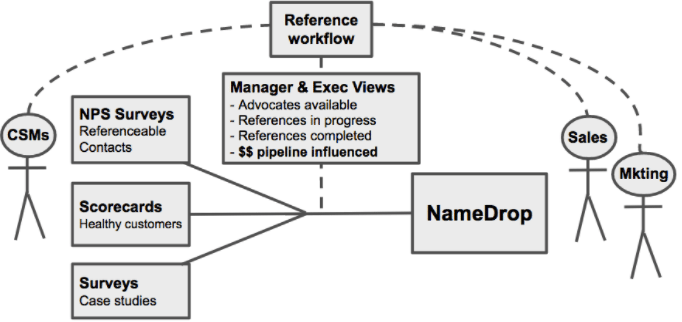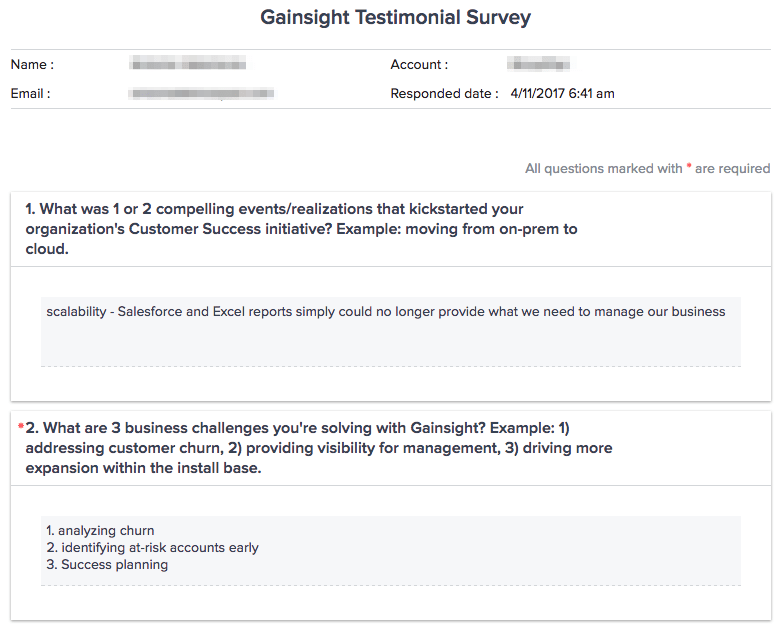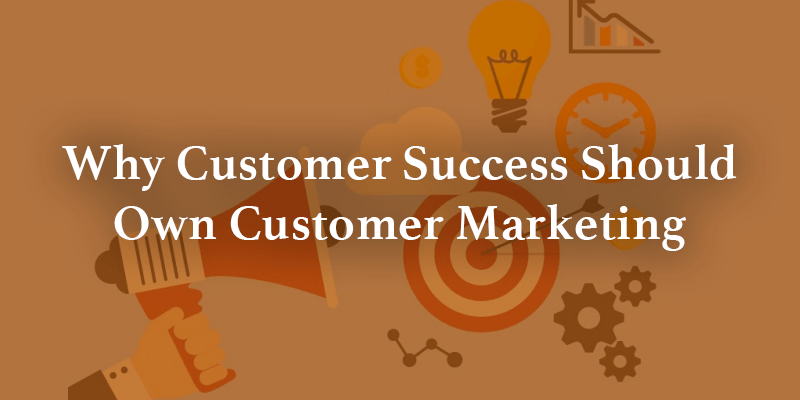A friend who is a salesperson at an enterprise SaaS company recently emailed me: “It’s the wild west here to get a customer reference. Nobody has any idea where to go or what to do. It slows me down immensely.”
A well-functioning Customer Marketing function can be a fountain of value, solving this problem plus so many more.
Six months ago, we moved Customer Marketing from our Marketing department to our Customer Success organization. My job changed too. I did not change departments, but my role shifted from being our Gainsight Admin to being our lead for Customer Marketing.
Below are my thoughts on why putting Customer Marketing into Customer Success was the right decision, the path we took, and why I think Customer Marketing is critical for a business’ Customer Success strategy.
What is Customer Marketing?
For us, it’s everything to do with Customer Advocacy. Other names I’ve heard for this are “Client Advocacy,” “Advocate Marketing,” “Reference Coordination,” or just “Advocacy.” We’re investing here because it is 1) highly effective at building prospects’ confidence and 2) very cost effective.
The meaning of “Customer Marketing” varies widely by company. In just the past day, I’ve talked with 2 other Customer Marketing teams that have little to do with advocacy. One was focused on customer journey building—something I’d call Customer Success Operations. The other was focused on Upsell/Cross-sell lead generation. The ambiguity around the term “Customer Marketing” makes it challenging to build a network of peers. I think we’d all benefit from a standardization of the function name.
The duty most frequently owned by Customer Marketing/Advocacy teams is coordinating sales reference calls. Many teams also own case studies, but this is often a tug-o-war with Marketing. Other duties commonly owned are:
- Customer webinars & podcasts
- Coordinating customer speakers to marketing events or prospect dinners
- Managing online reviews
- Managing online advocacy platforms (such as Influitive)
- NPS programs
What is Customer Marketing at Gainsight?
Employees often mistake me for part of the Marketing team. Not true! We are part of the Customer Success organization that is under our Chief Customer Officer.
Currently, we are a team of 2: myself and one other teammate based out of India. Our primary objectives are:
- Expanding Revenue → Grow, accelerate and win pipeline through customer advocacy
- Highlighting Success → Provide customers a stage to showcase their success
- Evangelize Customer Marketing using Gainsight → Pressure-test the Gainsight platform for a Customer Marketing persona and figure out best practices
Right now, our main areas of ownership are:
- Sales reference calls
- Customer case studies
- Online Advocacy (review sites and our Influitive hub)
- Providing well matched advocates for Sales and Marketing field events, such as Pulse
- Operationalizing advocacy as part of the customer journey
- Increasing product adoption by sharing customers’ use cases
- Evangelizing Gainsight for new use cases and functions
- Ad hoc requests from Sales, Marketing and Customer Success
Today, we’re using Gainsight heavily to manage our Customer Marketing efforts. Everything in this graphic is supported by Gainsight (I’ll write more on this in the near future):

Why should Customer Marketing live in Post-Sales?
Customer Marketing manages a supply of advocates and a demand for advocacy. At Gainsight, the supply is mostly funneled through the CSM team. The demand mostly comes from Sales and Marketing.
Advocacy demand from Sales and Marketing is self-generating. Market pressures, buying cycles, competitive evaluations, lead campaigns, etc. all need customer-generated content and references. While the desired types of assets and advocates can vary widely, an injection of customer advocacy is always needed somewhere.
Advocacy supply won’t self-generate so often. Now and then, a customer will proactively let a CSM know they’re happy to serve as a reference or do a case study. And salespeople often have back-pocket, “go-to” references. But to scale the value our customers can add to Sales and Marketing, we needed to increase our advocacy supply by:
- Operationalizing how to identify, track and manage advocates
- Streamlining processes for producing collateral and coordinating reference calls
- Factoring advocacy into the scope of the CSMs’ job
By moving Customer Marketing closer to the customers—the supply side—we could effectively address the root causes behind #1 & #2. To address #3, we added a target to CSMs’ compensation plans for Customer Success Qualified Advocacy (“CSQA”). This made CSMs accountable for helping to generate and capture a certain amount of advocacy per quarter.
What was our approach in the first 30, 90 and 180 days?
Two weeks before transition, I:
- Drafted our charter, set goals and a Gantt chart for the next 2 quarters, and got feedback from our executive team. I wanted to be sure that I was aligned with the strategic vision for the coming fiscal year.
- Held several knowledge transfers with members of our Marketing team to understand how they were currently conducting sales reference calls, case studies, engaging with online review sites, etc.
First 30 days, I:
- Finalized our charter and quarterly goals.
- Configured a process in Gainsight for the Sales team to request references.
- Coordinated my first few case study interviews with customers.
- Launched an internal initiative to better document customer attributes, so we can more strategically search our customer base for certain reference requests.
By 90 days, I:
- Hired our Customer Marketing Analyst to take ownership of sales reference calls, case studies, managing online reviews, and our Influitive hub.
- Began proactively meeting with our sales Regional VPs every 2 weeks to get ahead of reference call requests.
- Re-evaluated our approach to case studies. We had produced a few, but the process was slow and cumbersome. The Sales team needed 10x more than we were producing.
- Started providing our Sales and Marketing teams with advocates who could speak and participate at field events, prospect dinners, etc.
By 180 days, we:
- Configured and launched NameDrop internally, and then to customers. It allows Sales to self-service by proactively providing lists of similar, healthy customers, and references. It’s also been very helpful when our Account Executives are preparing RFPs because we often provide many potential references (sometimes on very short notice!).
- Reviewed our customer contracts to aggregate our customer logo use permissions into one place, then loaded it into Gainsight.
- Launched Online Review campaigns to strengthen our presence on third-party review sites.
- Put a new case study process in motion. We use a Gainsight Survey to collect necessary content and permissions upfront, which we then convert into one-slide case studies.
You can download the Survey template from Vault here. We’re now producing 5-10 one-slide case studies per week. - Took on a major role in Pulse planning, where we are:
- Coordinating our Enterprise Showcase track in partnership with TSIA
- Conducting about 25 customer testimonial video interviews
- Presenting on Customer Marketing
- Running an Experience through our Influitive Hub
Here’s a real example of a case study survey that one of our customers filled out. The full response contains answers to 7 questions.

What’s our vision for the next 6 months?
- We need to find more impactful metrics. Most Customer Marketers are tracking dollars of pipeline influenced by advocacy as a key metric, ourselves included. While it’s a good place to start, this is a slippery metric. Quarter over quarter, the threshold of what it means to “influence” pipeline can become looser, causing the metric to balloon. I want to prove that we’re actually moving the needle by tracking changes in New Deal time-to-close and likelihood-to-close when touched by advocacy.
- We need to hire and separate Content Creation vs. Customer Coordination roles. Examples of the former are drafting case studies or converting content between formats. Examples of the latter are coordinating references or line-ups of customer webinars. The switching cost of going between the two can be very high, and they also emphasize different skill sets.
- Show Customer Success leaders the value of taking on Customer Marketing. Many Customer Success orgs have been challenged to prove their value to Sales and Marketing. Customer Marketing adds an indispensable value to those teams. Giving CSMs a quarterly CSQA target has created a steady flow of advocacy potential. It’s a sprinkler we can use to water our whole lawn, and a firehose when we need a lot of advocates directed towards something quickly.

